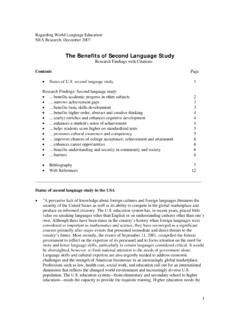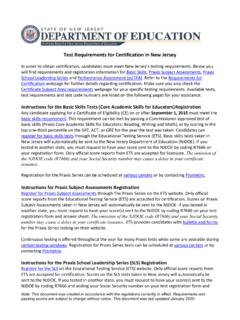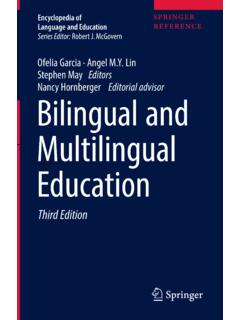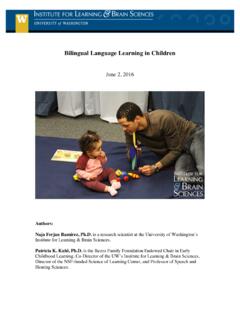Transcription of The Roles of English Language Education in Asian Context
1 Pan-Pacific Association of Applied Linguistics 15(1), 191-206 191 C 2011 PAAL 1345-8353/00 The Roles of English Language Education in Asian Context * Bok-Myung Chang Namseoul University Chang, .B-M. (2011). The Roles of English Language Education in Asian Context . Journal of Pan-Pacific Association of Applied Linguistics, 15(1), 191-206. This study surveys the history of English Language and the Roles of English Language Education in Asian Context . Through the historical survey on English dispersal in Asian countries, the first section of this study traces the dispersal of English from the 18th century and the development of English in Asian countries.
2 The second section of this study explains the development and characteristics of English Language Education policies in Asian countries. These countries belong to the expanding circle according to Kachru s model, and in the expanding circle, English plays a very important role as a tool for interaction among nonnative speakers. This section surveys and compares the developmental characteristics of English Language Education in Asian countries. The third section emphasizes the important role of English Education and the future of English Language Education in Asian countries. Also this section focuses on the characteristics of English as an International Language , and emphasizes the role of English as a tool for inter-cultural communication in the world.
3 The purpose of English Language Education in the Asian Context is to cultivate young people who are well equipped with English capabilities and their own professional abilities. Key Words: Kachru s model, Asian countries, English Language , the policy of English Language Education , Roles of English Language Education 1 Introduction The history of English Language in Asian countries is very important to understand the characteristics of English Language Education comparing with those of the countries which belongs to the Inner circle. The information of historical background for Asian Englishes is very important to set up the Roles of English Language Education in Asian Context . So this research focuses to survey the development of English Language and define the Roles of English Language Education in Asian countries: Singapore, Philippine, Hong Kong, China, Malaysia, Taiwan, Japan, and Korea.
4 * Funding for this paper was provided by Namseoul University in 2010. Bok-Myung Chang 192 The purposes of this study are as follows: the first one is to trace the dispersal of English from the 18th century and the development of English in Asian countries, the second one is to explain the development and characteristics of English Language Education policies in Asian countries, and the third one is to emphasize the important role of English Education and the future of English Language Education in Asian countries. The data for this research is based on the textbooks and materials for the development of English Language and Education policies from the governments of Asian countries.
5 2 Historical Survey on English Language in Asian Context The history of English Language in Asian countries is closely related to the dispersals of English which consists of two kinds of dispersals. The first one involved the migration of many people from the south and eastern part of England to America and Australia. The second one involved the colonization of Asia and Africa, and led to the development of a number of second Language varieties. English dispersals in South-East Asia and the south pacific started in the late 18th century. The main countries involved were Singapore, Malaysia, Hong Kong, and the Philippines. Stamford Raffles, an administrator of the British East India Company, played an important role in the founding of Singapore as part of the British colonial empire in 1819.
6 Around the same time, other major British centers were founded in Malaysia, and in 1842, Hong Kong was added to Britain. After the Spanish-American War at the end of the 19th century, the United States was granted sovereignty over the Philippines. Through the above historical development, English came to play very strong influence over many Asian countries. This section surveys the development of English Language Education in Asian countries: Singapore, Philippine, Hong Kong, China, Malaysia, Taiwan, Japan, and Korea. Historical survey on the development of English Education is very important for defining the Roles of English Language Education and giving the directions for English Education in the future. Historical dimension of Singapore English Singapore had been colonized by the United Kingdom in the 19th century when Sir Stamford Raffles founded the part of Singapore as a trading post for the East India Company in 1819 and became separated and independent from Malaysia in 1965.
7 The population of Singapore is like this: Chinese - , Malay - , Indian - , and other races (Gupta, 2006; Lim & Foley, 2004). Mandarin has become the most powerful and frequently used native Language among the three indigenous languages, Mandarin, Malay, and Tamil since the Speak Mandarin Campaign was launched in 1979 by the English Language Education in Asian Context 193 then Prime Minister Lee Kuan Yew. Official languages in Singapore are English , Mandarin, Malay, and Tamil (Lin, 2002). Since its independence, the Singaporean government has launched a bilingual Education policy with an ever increasing emphasis on the use of English (Rubdy, 2001). Therefore currently, English is the Language of Education in all levels and types of schools in Singapore.
8 English is the primary Language in various sectors of the Singaporean society including public administration, Education , commerce, science and technology (Lin, 2002). Letters and workplace documents in government offices, business contracts, and public signs are written in English . All subjects except the mother tongue classes are instructed in English . Platt and his associates (Platt, 1975; Platt & Weber, 1980) recognized two distinct varieties: one is formal English as the H variety, and the other is informal English as the L variety. According to Gupta (1991, 1994), the formal one can be classified as Singapore Standard English (SSE) and the informal one Singapore Colloquial English (SCE). SSE is officially learned at schools, and it is not different from a Standard English such as British or American English , with a few differences in pronunciation and a few lexical borrowings.
9 On the other hand, SCE is learned and used in vernacular situations. In fact when a child is born in Singapore, she acquires SCE first. In a sense, it is the native Language of Singaporeans. About million people speak SCE or Singlish at home, on the streets, and at shopping malls. They even enjoy Singaporean actors and actresses speaking Singlish. However, SCE has been negatively perceived as bad English by the society. The Speak Good English Movement Campaign was launched to eradicate this so-called bad English . Singlish is strongly discouraged in schools, at workplaces, and in the media. However, some Singaporeans argue that Singlish identifies them and bonds them as Singaporeans in this multi-racial, linguistic, and cultural society.
10 The role of Singlish, therefore, is to establish group identity and solidarity in a sense (Rubdy, 2001). Historical dimension of Philippine English The Philippines is well-known for its large English -speaking population. In fact, it is the third largest English -speaking country (Bolton & Bautista, 2004; Gonzalez, 2004). English is indeed the major Language in public and personal life of Filipino people. It is a co-official Language used in various sectors including government, law and Education (Bolton & Bautista, 2004). In addition, it plays a major role in print media, films, television, and creative writing. From 1565 to 1898, the Philippines were dominated by Spain who introduced Catholicism into this nation. From 1898 to 1941, the USA colonized the Philippines.


















